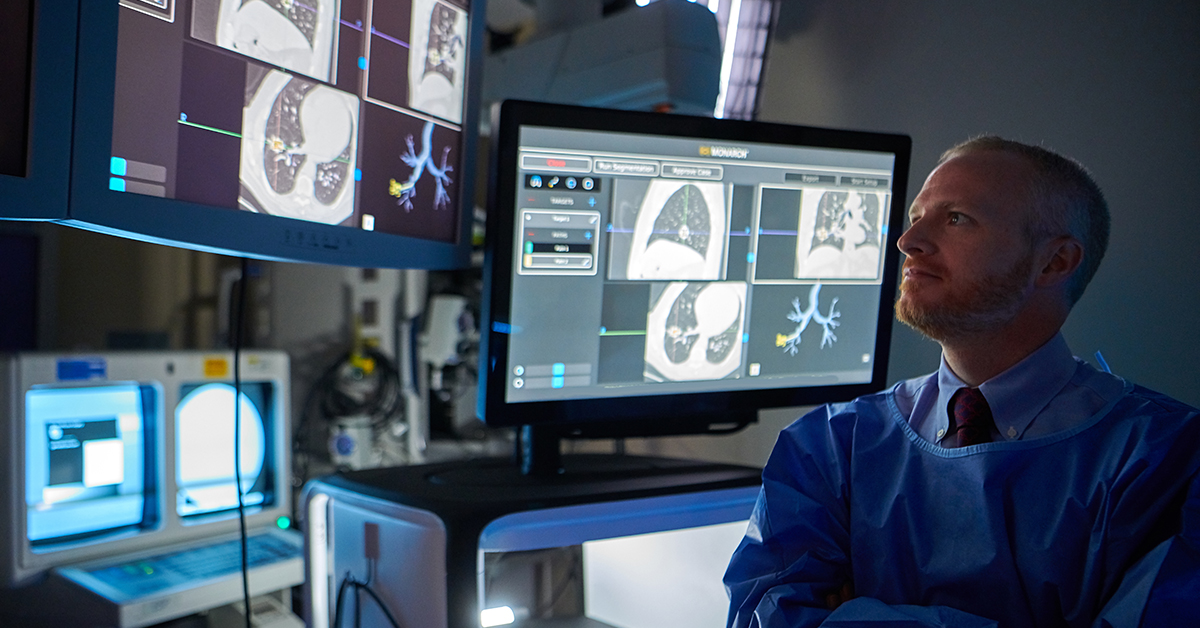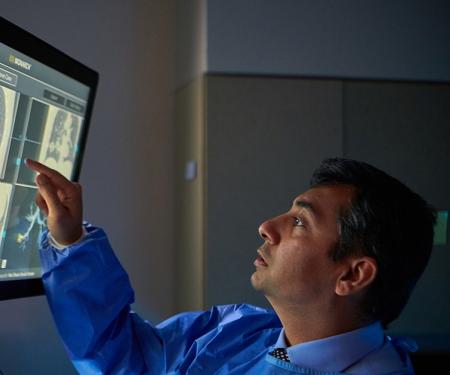
Robotic bronchoscopy can enable earlier and more accurate diagnosis of lung nodules. Traditional bronchoscopy is less likely to detect nodes that are small or in hard-to-reach areas, and may delay diagnosis. The Monarch Platform used at Fox Chase integrates the latest advances in robotics, endoscopy, computer-assisted navigation, and 3-D imagery to diagnose lung nodules.
Fox Chase was one of the first cancer centers in the country to offer robotic bronchoscopy through the Monarch Platform. Our physicians are national leaders in utilizing the technology and share their advanced experience with other physicians through a case observation program.
A Technological Leap
Robotic bronchoscopy allows physicians to visualize and biopsy remote parts of the lung that were previously inaccessible. Physicians use a hand-held controller to very precisely navigate a small, flexible endoscope into the lung. An endoscope is a hollow tube fitted with a camera-like lens and light source. The new robotic platform has an innovative telescoping endoscope attached to flexible robotic arms that allow greater dexterity, reach, vision, and control.
Integrated software combines traditional endoscopic views of the lung with computer-assisted navigation, all based on 3-D models of the patient’s own lung anatomy. Physicians are able to visualize the lung continuously throughout the entire procedure. The consistency and reproducibility achieved far exceed traditional bronchoscopy, allowing rapid, accurate diagnosis. It is crucial to navigate the airways quickly and safely to get accurate answers. Fox Chase believes robotic bronchoscopy is the new standard of care for difficult-to-reach nodules.
The Patient Experience at Fox Chase
Highly trained, specialized physicians at Fox Chase perform robotic bronchoscopy. Bronchoscopy is a minimally invasive technique that does not require opening the chest.
Patients undergoing bronchoscopy meet with their Fox Chase care team the day of the procedure. The entire process typically takes about 4-6 hours. The bronchoscopy itself usually lasts less than an hour. Once the patient is fully anesthetized, a small, flexible endoscope fitted with a lens and tools enters the body so that physicians can look inside the lungs. The robotic navigational guide gives turn by turn directions to get to nodules. Physicians can fully visualize the lungs, taking tiny pieces of the nodule or lung tissue as needed. Lymph nodes are also inspected using endoscopic bronchial ultrasound so that lymph node staging can be done at the same time. Results are usually available within a few days. It can take longer if a biopsy was done because the pathologist needs time to carefully prepare and evaluate the tissue.
Fox Chase is a NCI-Designated Comprehensive Cancer Center where bronchoscopy has been done successfully for many years, and where the new robotic platform is now used routinely. Identifying nodules earlier, when they are smaller, can translate to earlier diagnosis and better outcomes.

